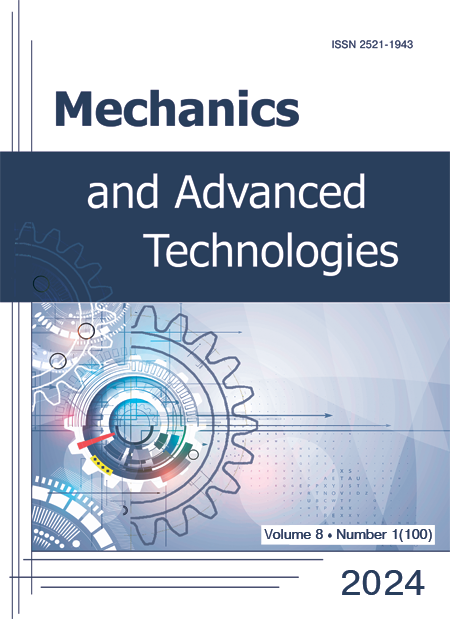Numerical Study on Simulating the Deposition Process of Cold Spray Multi-Particle Al-6061 based on CEL Method
DOI:
https://doi.org/10.20535/2521-1943.2024.8.1(100).295144Keywords:
Coupled Eulerian-Lagrangian,, Al6061, multi-particle, Substrate, TemperatureAbstract
Cold spray is a solid-state deposition technique that improves the performance of part surfaces. Most scholars use the CEL framework to simulate the deposition of single particles on the substrate; Single particle depositions cannot fully characterize coating conditions. This article proposes to use the CEL method to simulate the deposition process of cold spray multi-particles on the Al6061 substrate. A multi-particle wrapped model is nested in a deposition model created by CEL to simulate the cold spray multi-particle deposition process. The Euler-Lagrangian method has the characteristics of high accuracy and robustness, and was selected as the method for multi-particle deposition model simulation; The CEL framework is a feasible method to simulate the actual cold spray multi-particle deposition process. The results show that the CEL framework can simulate the deposition of cold sprayed Al6061 multi-particles on the Al6061 substrate, observe the EVF Void value of the coating, and monitor the porosity of the coating after deposition. It is observed that the maximum substrate surface temperature after deposition is 528.2K and is located at the junction of particle and particle impact; By analyzing the temperature change curve of five points collected on the substrate over time, the curve appears multiple inflection points, indicating that heat transfer occurs between the particles and the substrate during the deposition process; the substrate first heats up and then cools down. During the multi-deposition process, the particles undergo plastic deformation and continuously squeeze the coating, thereby achieving interconnection between the particles and the substrate; Mechanical interlocking between particles forms a coating.
References
- S. T. Oyinbo and T.-C. Jen, “A comparative review on cold gas dynamic spraying processes and technologies”, Manufacturing Review, vol. 6, no. 25, p. 25, 2019. DOI: https://doi.org/10.1051/mfreview/2019023.
- H. Assadi, F. Gärtner, T. Stoltenhoff and H. Kreye, “Bonding Mechanism in Cold Gas Spraying”, Acta Mater., vol. 51, no. 15, pp. 4379–4394, 2003. DOI: https://doi.org/10.1016/S1359-6454(03)00274-X.
- T. Schmidt, F. Gärtner, H. Assadi and H. Kreye, “Development of a Generalized Parameter Window for Cold Spray Deposition”, Acta Mater., vol. 54, no. 3, pp. 729–742, 2006. DOI: https://doi.org/10.1016/j.actamat.2005.10.005.
- A. M. Vilardell, N. Cinca, A. Concustell, S. Dosta, I. G. Cano and J. M. Guilemany, “Cold spray as an emerging technology for biocompatible and antibacterial coatings: state of art”, J. Mater. Sci., vol. 50, no. 13, pp. 4441–4462, 2015. DOI: https://doi.org/10.1007/s10853-015-9013-1.
- V. Champagne and D. Helfritch, “Critical assessment 11: structural repairs by cold spray”, Mater. Sci. Technol., vol. 31, no. 6, pp. 627–634, 2015. DOI: https://doi.org/10.1179/1743284714Y.0000000723.
- W. Hu, K. Tan, S. Markovych and T. Cao, “Research on structure and technological parameters of multi-channel cold spraying nozzle”, EEJET, vol. 5, no. 1 (113), pp. 6–14, Oct. 2021. DOI: https://doi.org/10.15587/1729-4061.2021.242707.
- M. R. Rokni, C. A. Widener, O. C. Ozdemir and G. A. Crawford, “Microstructure and Mechanical Properties of Cold Sprayed 6061 Al in As-Sprayed and Heat Treated Condition”, Surf. Coat. Technol., vol. 309, pp. 641–650, 2017. DOI: https://doi.org/10.1016/j.surfcoat.2016.12.035.
- M. Saleh, V. Luzin and K. Spencer, “Analysis of the residual stress and bonding mechanism in the cold spray technique using experimental and numerical methods”, Surf. Coat. Technol., vol. 252, pp. 15–28, 2014. DOI: https://doi.org/10.1016/j.surfcoat.2014.04.059.
- E. Lin, Q. Chen, O. C. Ozdemir, V. K. Champagne and S. Müftü, “Effects of Interface Bonding on the Residual Stresses in Cold-Sprayed Al-6061: A Numerical Investigation”, Journal of Thermal Spray Technology, vol. 28, no. 3, pp. 472–483, 2019. DOI: https://doi.org/10.1007/s11666-019-00827-7.
- X. Song, K. L. Ng, J. M.-K. Chea, W. Sun, A. W.-Y. Tan, W. Zhai, F. Li, I. Marinescu and E. Liu, “Coupled Eulerian-Lagrangian (CEL) simulation of multiple particle impact during Metal Cold Spray process for coating porosity prediction”, Surface and Coatings Technology, vol. 385, p. 125433, 2020. DOI: https://doi.org/10.1016/j.surfcoat.2020.125433.
- M. Hassani-Gangaraj, D. Veysset, V. K. Champagne, K. A. Nelson and C. A. Schuh, “Adiabatic shear instability is not necessary for adhesion in cold spray”, Acta Mater., vol. 158, pp.430–439, 2018. DOI: https://doi.org/10.1016/j.actamat.2018.07.065.
- A. Fardan, C. C. Berndt and R. Ahmed, “Numerical modelling of particle impact and residual stresses in cold sprayed coatings: A review”, Surface and Coatings Technology, vol. 409, p. 126835, 2021. DOI: https://doi.org/10.1016/j.surfcoat.2021.126835.
- W. Xie, A. Alizadeh-Dehkharghani, Q. Chen, V. K. Champagne, X. Wang, A. T. Nardi, S. Kooi, S. Müftü and J.-H. Lee, “Dynamics and Extreme Plasticity of Metallic Microparticles in Supersonic Collisions”, Sci. Rep., vol. 7, no. 1, p. 5073, 2017. DOI: https://doi.org/10.1038/s41598-017-05104-7.

- M. A. Meyers, Plastic Deformation at High Strain Rates, in Dynamic Behavior of Materials, Wiley: New York, 1994, pp. 323–381. DOI: https://doi.org/10.1002/9780470172278.ch13.
- JAHM Software Inc., Material Properties Database MPDB (2003); V7.01 demo.
- K. Tan, “Analysis of spray particles entrance of Right-angle cold spray nozzle based on CFD”, Mech. Adv. Technol., vol. 7, no. 3 (99), pp. 325–329, Dec. 2023. DOI: https://doi.org/10.20535/2521-1943.2023.7.3.292244.
Downloads
Published
How to Cite
Issue
Section
License
Copyright (c) 2024 Kun Tan

This work is licensed under a Creative Commons Attribution 4.0 International License.
Authors who publish with this journal agree to the following terms:
- Authors retain copyright and grant the journal right of first publication with the work simultaneously licensed under CC BY 4.0 that allows others to share the work with an acknowledgement of the work's authorship and initial publication in this journal.
- Authors are able to enter into separate, additional contractual arrangements for the non-exclusive distribution of the journal's published version of the work (e.g., post it to an institutional repository or publish it in a book), with an acknowledgement of its initial publication in this journal.
- Authors are permitted and encouraged to post their work online (e.g., in institutional repositories or on their website) prior to and during the submission process, as it can lead to productive exchanges, as well as earlier and greater citation of published work











